Related Research Articles

RuneQuest is a fantasy tabletop role-playing game originally designed by Steve Perrin, Ray Turney, Steve Henderson, and Warren James, and set in Greg Stafford's mythical world of Glorantha. It was first published in 1978 by The Chaosium. Beginning in 1984, publication passed between a number of companies, including Avalon Hill, Mongoose Publishing, and The Design Mechanism, before finally returning to Chaosium in 2016. RuneQuest is notable for its system, designed around percentile dice and an early implementation of skill rules, which became the basis for numerous other games. There have been several editions of the game.

Arduin is a fictional universe and fantasy role-playing system created in the mid-1970s by David A. Hargrave. It was the first published "cross-genre" fantasy RPG, with everything from interstellar wars to horror and historical drama, although it was based primarily in the medieval fantasy genre.
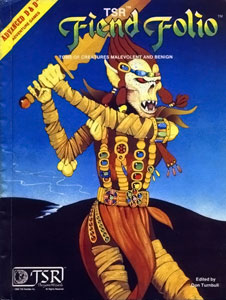
Fiend Folio is the name of three separate products published for successive editions of the fantasy role-playing game Dungeons & Dragons (D&D). All three are collections of monsters.
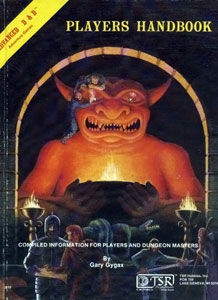
The Player's Handbook is the name given to one of the core rulebooks in every edition of the fantasy role-playing game Dungeons & Dragons (D&D). It does not contain the complete set of rules for the game, and only includes rules for use by players of the game. Additional rules, for use by Dungeon Masters (DMs), who referee the game, can be found in the Dungeon Master's Guide. Many optional rules, such as those governing extremely high-level players, and some of the more obscure spells, are found in other sources.

The Dungeon Master's Guide is a book of rules for the fantasy role-playing game Dungeons & Dragons. The Dungeon Master's Guide contains rules concerning the arbitration and administration of a game, and is intended for use by the game's Dungeon Master.

Tomb of Horrors is an adventure module written by Gary Gygax for the Dungeons & Dragons (D&D) role-playing game. It was originally written for and used at the 1975 Origins 1 convention. Gygax designed the adventure both to challenge the skill of expert players in his own campaign and to test players who boasted of having mighty player characters able to best any challenge. The module, coded S1, was the first in the S-series, or special series of modules. Several versions of the adventure have been published, the first in 1978, and the most recent, for the fifth edition of D&D, in 2017 as one of the included adventures in Tales from the Yawning Portal. The module also served as the basis for a novel published in 2002.

In Search of the Unknown is a module for the Dungeons & Dragons roleplaying game, designed for use with the Basic Set of rules. It was written by game designer Mike Carr and was first published in 1978 by TSR, Inc. The module details a hidden complex known as the Caverns of Quasqueton. Reviewers considered it a good quality introduction to the game that was written in the so-called dungeon crawl style, where the primary goal of the players is the exploration of a dangerous labyrinth to battle monsters and obtain treasure.
The fighter is one of the standard playable character classes in the Dungeons & Dragons fantasy role-playing game. A fighter is a versatile, weapons-oriented warrior who fights using skill, strategy and tactics.
The monk is a playable character class in most editions of the Dungeons & Dragons fantasy role-playing game. A D&D monk is a fantasy martial artist, specializing in unarmed combat.

White Plume Mountain is an adventure module for the Advanced Dungeons & Dragons fantasy role-playing game, written by Lawrence Schick and published by TSR in 1979. The 16-page adventure bears the code "S2". The adventure is a dungeon crawl where the players' characters are hired to retrieve three "notorious" magical weapons, each possessing its own intelligence. The adventure contains art by Erol Otus, and a cover by Jeff Dee. A sequel, Return to White Plume Mountain, was published in 1999, and an updated version conforming to v3.5 rules was released online in 2005. The original was again updated for the 5th edition in 2017 as the fourth part of Tales from the Yawning Portal.
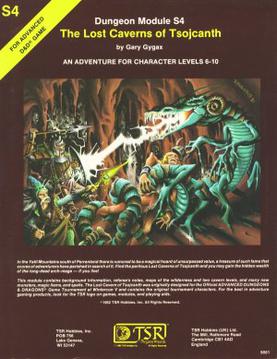
The Lost Caverns of Tsojcanth is an adventure module for the Dungeons & Dragons fantasy role-playing game. It was written by Gary Gygax and published by TSR in 1982 for the first edition Advanced Dungeons & Dragons (AD&D) rules. The 64-page adventure bears the code "S4" and is set in the Greyhawk campaign setting. It is divided into two parts, a 32-page adventure, and a 32-page booklet of monsters and magic items. The plot involves the player characters investigating rumors of lost treasure. After traversing a wilderness and two levels of dungeons, the players face Drelnza, the vampiric daughter of long-deceased archmage Iggwilv.
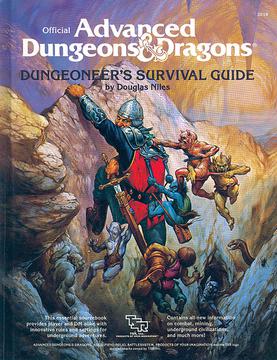
Dungeoneer's Survival Guide is a supplement to the Dungeons & Dragons fantasy role-playing game. The book was written by Douglas Niles, and published by TSR, Inc. in 1986.

The Dungeons & Dragons Companion Set is an expansion boxed set for the Dungeons & Dragons (D&D) fantasy role-playing game. It was first published in 1984 as an expansion to the Dungeons & Dragons Basic Set.

Dungeons & Dragons Master Rules is an expansion boxed set for the Dungeons & Dragons (D&D) fantasy role-playing game. It was first published in 1985 as an expansion to the Basic Set.

The Expert Set is an expansion boxed set for the Dungeons & Dragons fantasy role-playing game. It was first published in 1981 as an expansion to the Basic Set.

High Fantasy is a fantasy role-playing game system originally published by Fantasy Productions in 1978. A second edition in 1981 and several subsequent books were published by Reston Publishing that featured solo adventures using the High Fantasy system. The game received mixed reviews in game periodicals including White Dwarf, The Space Gamer, Different Worlds, Ares, and Dragon.

Field Guide to Encounters is a role-playing game published by Judges Guild in 1982.

The Dragon Crown is an adventure for fantasy role-playing games published by Judges Guild in 1979.
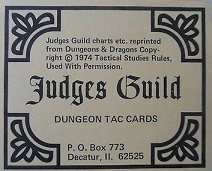
Dungeon Tac Cards is a supplement for fantasy role-playing games published by Judges Guild in 1976.

The Manual of Aurania is a 24-page supplement for fantasy role-playing games self-published in 1976 and sold at Aero Hobbies, a games store in Santa Monica, California owned by Gary Switzer. A 34-page 2nd edition revision of the book was later published by International Gamers Association with numerous added illustrations in 1977.
References
- 1 2 3 4 5 6 7 8 Schick, Lawrence (1991). Heroic Worlds: A History and Guide to Role-Playing Games. Prometheus Books. p. 307. ISBN 0-87975-653-5.
- 1 2 3 4 5 6 7 Turnbull, Don (December 1978 – January 1979). "Open Box". White Dwarf (review). Games Workshop (10): 16.
- 1 2 Holm, Dana (January–February 1979). "The Realm of Yolmi: a review". The Space Gamer . Metagaming (21): 22.